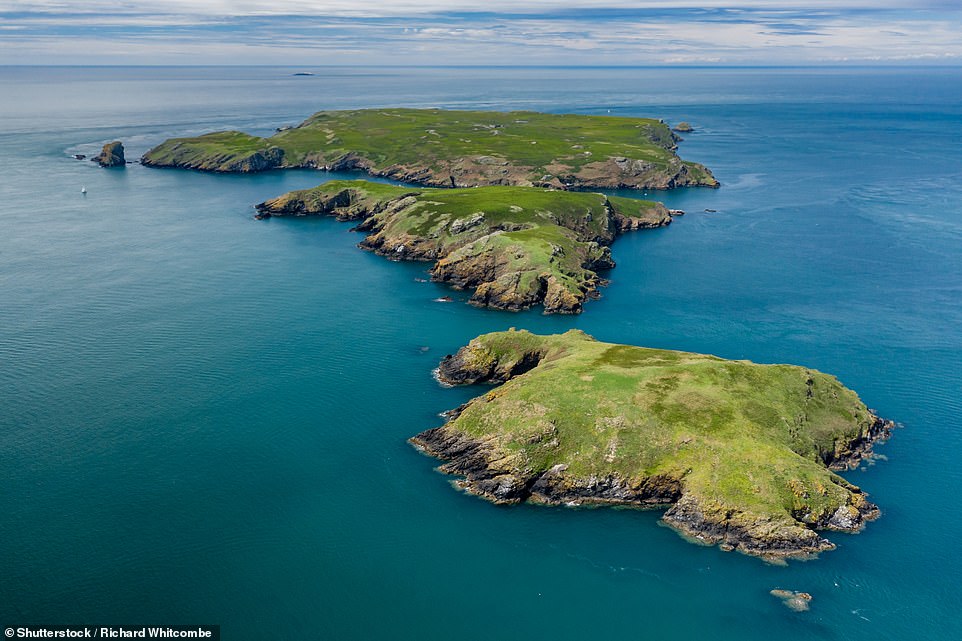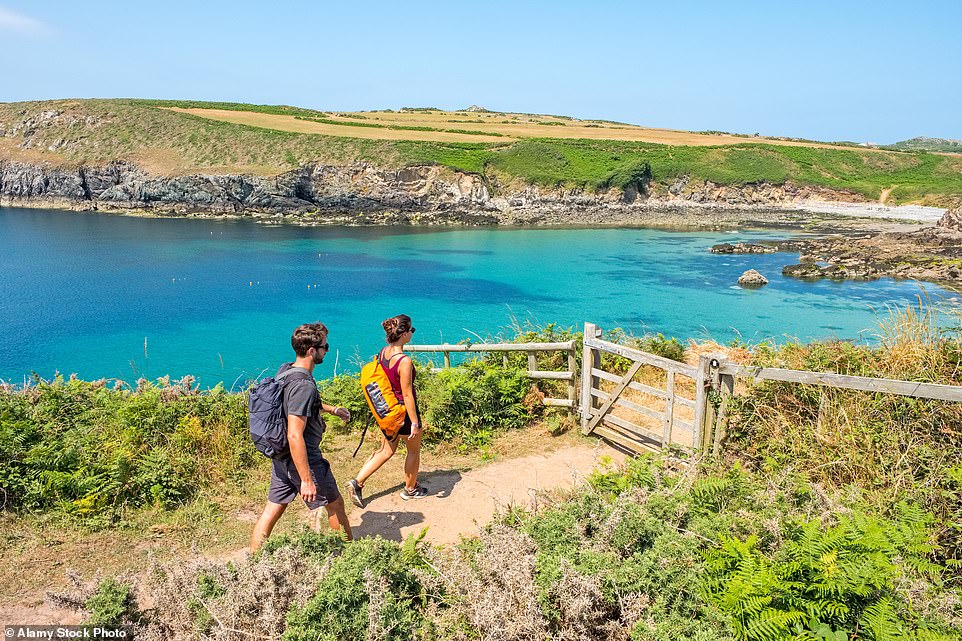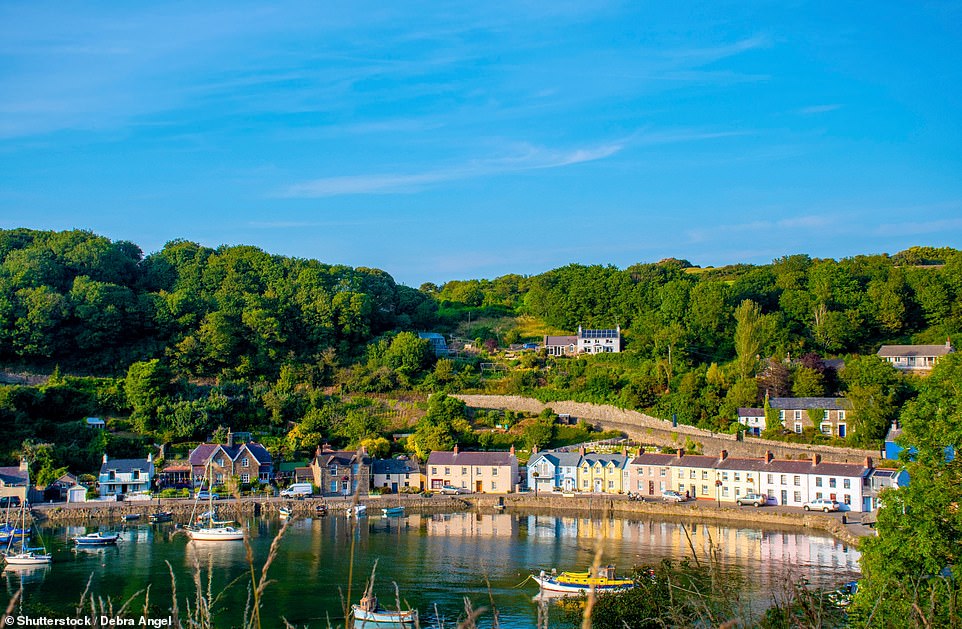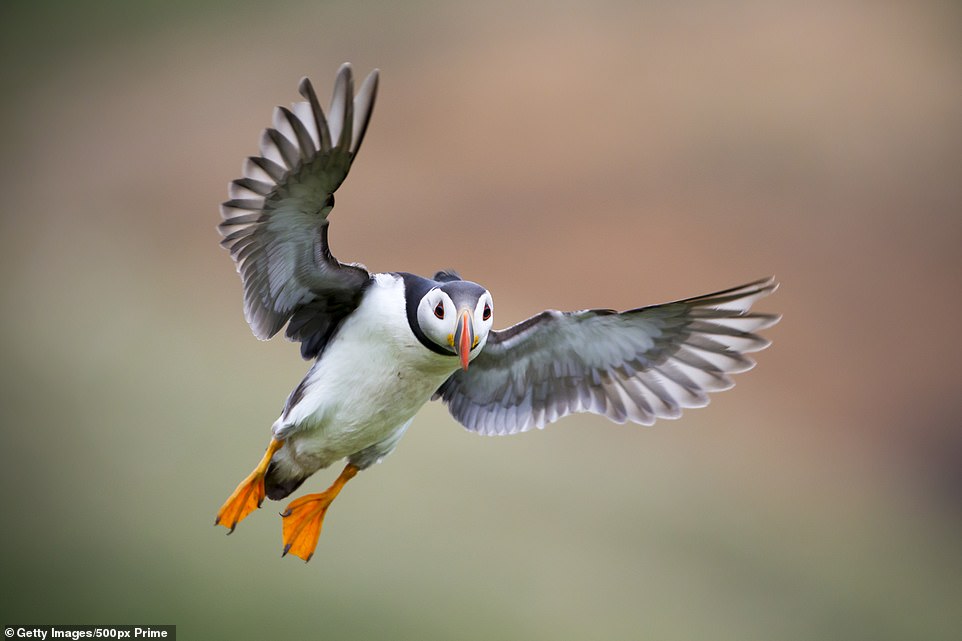A whirr of wings as a bird approaches the landing ground on a wide, green plateau of Skomer Island, guarded by majestic cliffs and the wild Atlantic.
Close-up, the powerful flier turns into an endearingly plump and ungainly figure, splaying out its big, webbed, orange feet and winding its wings back to slow and stall. Finally, it plops down into the grass near to its mate and their sandy burrow.
Quite a few of the birds actually land so clumsily that they do a beak-dive and tumble, only to pick themselves up, look rapidly about to make sure no one is watching and then waddle over to their nest.

Puffins arrive in vast numbers to nest on Skomer Island, off the coast of Pembrokeshire, every May
The Atlantic puffin is probably the most appealing of British birds. Even its Latin name is ridiculously cute: Fratercula arctica, meaning Arctic Friar, as its black-and-white plumage looks something like a monkish robe. But this could also be translated as Little Arctic Brother. I love that.
I’ve driven out west to Pembrokeshire, the Welsh region with probably the gentlest appeal — although really they’re all special, from the thinly peopled hill country of Powys, to the dark mountains of Snowdonia, or Eryri, as locals call it.
Just as it’s only polite to learn a little French when going to France, one should learn a bit of Welsh if going to Wales. When two ladies stand aside on a narrow stretch of coastal path for me to pass, I say ‘thank you’ and they say ‘Croeso’. ‘You’re welcome.’ ‘Diolch!’ (‘Thank you’), I call back. They smile. It’s not hard.
It’s the coastal path I’m here for — and the puffins, which arrive in vast numbers to nest on Skomer and nearby Skokholm Island every May. I drive down through Marloes — ‘Twinned with Llareggub,’ reads a cheerfully irreverent sign at the village edge. An old Dylan Thomas joke. (Read Llareggub backwards and you’ll get it.)

Winging it: Walking the coast path near St David’s where the waters are crystal clear (stock image)
We sail from tiny Martin’s Haven, a gaggle of bird lovers. The little boat rocks and rolls across the big grey swell, and you think again how lucky we are to live on such a wild sea-cloaked island, with more than 4,000 islands of at least half an acre.
Even before we come into Skomer’s North Haven, the seas and cliffs are clamorous with shearwaters and guillemots. But it’s the quaint and comical puffins we’ve come to see, so untroubled by humans that you can stand within a few feet of them as they waddle back and forth between their burrows; or stand sentry, watching anxiously for their mates to return from fishing; or have neighbourly tiffs here and there.
St David’s on the mainland is the starting point for this walking tour, where I spend my first evening on the beach at Caerfai Bay with a beer, watching the sunset. ‘Better than any pub garden, eh?’ says an old chap with a ponytail.
The next day is the trip to Skomer, and then many other glorious moments on this seven-day exploration of Pembrokeshire’s coastline. I walk ten to 12 miles a day. With plenty of bracing ups over headlands and downs to hidden coves, it is about five hours’ walking. In the little bay of Porthsychan I see five or six seals yards from the beach, eyeing me warily but curiously.
Dinas Head makes for a magnificent, near-circular walk, by way of Pwllgwaelod beach, returning to the sheltered cove of Cwm-yr-Eglwys. I go wrong a little after this, but it means I discover the fairy glen of Cwm Rhigian. And at Newport there is the wide sunlit estuary of Afon Nyfer, and excellent food and pints of Doom Bar at The Golden Lion.

The picturesque village of Fishguard with its cluster of colourful waterside cottages

‘The Atlantic puffin is probably the most appealing of British birds,’ writes the Daily Mail’s Christopher Hart
You should also eat at the Royal Oak in Fishguard, while imagining a crackpot little French invasion here in 1797, when troops surrendered to the Fishguard Fencibles, the Dad’s Army of the time. Why Fishguard? One explanation is that the French were very drunk.
In summer the clifftop paths are colourful with wildflowers and bees. It can be squally on this coast — this is part of the appeal. Mid-week a huge Atlantic storm sweeps in, and I spend a morning in pouring rain on Fishguard’s Marine Parade, and then the afternoon back at my B&B, reading old Welsh folk tales.
The next day, in rustling waterproofs, I set out for Strumble Head. The clifftop paths seem narrow indeed above the boiling white sea, and 50mph wind gusts buffet me. Exhilarating too, though, as I scramble over the steep tor of Garn Fawr, then down to the coast, and the lighthouse on Ynys Meical.
The wind eases, and I meet a man on the headland, watching the Manx Shearwaters.
‘I hope the puffins are all right on Skomer,’ I proffer.
‘They’ll be all right,’ he nods. ‘They were here before us, and they’ll still be here after we’re gone.’
TRAVEL FACTS
Mac’s Adventure offers six nights’ B&B on its Pembrokeshire Coast holiday, including daily luggage transfers and any transfers from your accommodation to the path, full guidance and routes and 24/7 support, from £595, macsadventure.com, 0141 530 8886. For the puffin trip to Skomer, visit pembrokeshire-islands.co.uk.
Advertisement
Source link : https://www.dailymail.co.uk/travel/escape/article-9797781/UK-staycation-Visiting-Skomer-Island-puffins-hiking-tour-Pembrokeshire-coast.html












